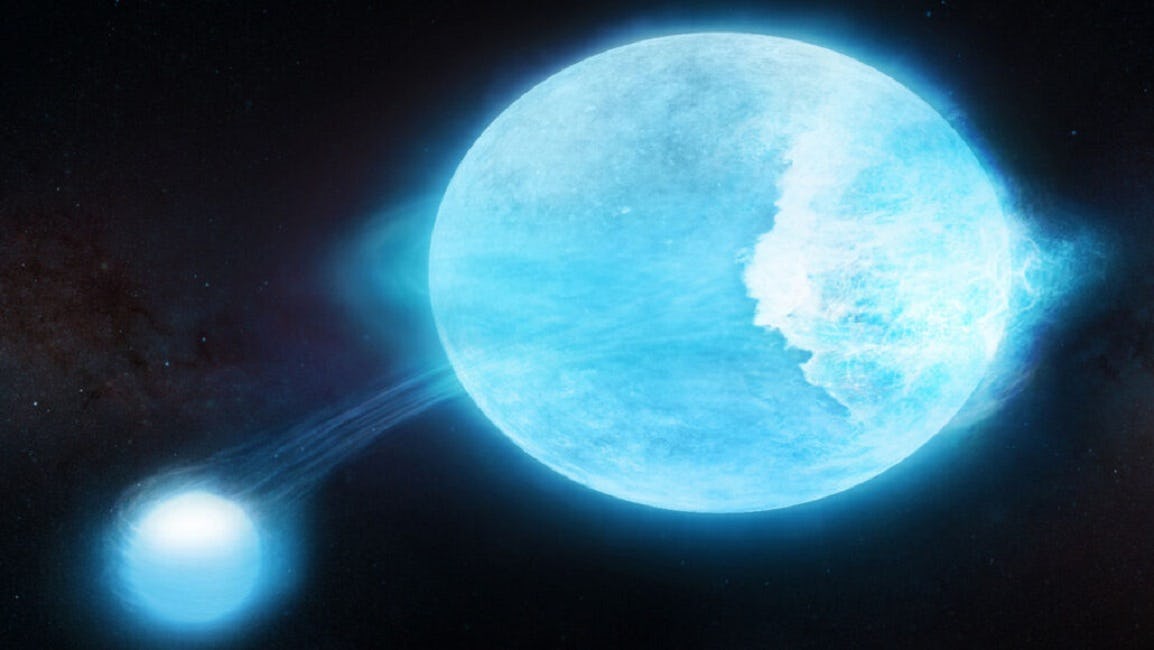
Astronomers recently used computer simulations to study the rise and fall of gargantuan tides on a distant massive star.
The highest tides on Earth happen in the Bay of Fundy on the southeastern coast of Canada, where high tides raise the water level by more than 38 feet. But on the massive star MACHO 80.7443.1718, high tides raise waves of plasma 2 million miles high. Harvard University astrophysicists Morgan MacLeod and Avi Loeb (yes, that Avi Loeb) recently used computer simulations to explore how plasma tidal waves behave when the star passes close to its smaller (but still ten times more massive than our Sun) companion.
They published their results in the journal Nature Astronomy.
Making Waves
160,000 light years away in the Large Magellanic Cloud, MACHO 80.7443.1718 is actually two stars: one about 35 times more massive than our Sun, and another that astronomers can only “see” from how it affects its larger, brighter companion. These two massive stars waltz around their shared center of gravity once every 33 days. Because their orbit is more of a stretched-out oval than a circle, the distance between them varies, and that creates massive tides that rise and fall in a dramatic but regular rhythm. Astronomers call pairs like this a “heartbeat” star.
“During each pass, each star’s huge gravitational forces create extreme tides on the other — so big, in fact, that they fly away ‘ringing,’ as their shapes wobble and shift around,” writes MacLeod in a blog post about his recent paper with Loeb. “Those wobbles affect the amount of light each star shines toward us here on Earth at a given time, and graphs of their brightness over time look a lot like a heart monitor’s output — earning them their name.”
The tides on most heartbeat stars are about 6,000 times higher than the more familiar tides in Earth’s oceans (and made of extremely hot plasma). But on MACHO 80.7443.1718, the tides are more than a million times higher than ocean tides here on Earth; their towering height is about a fifth of the star’s normal diameter. If you stacked three Suns on top of each other, they’d nearly be swallowed up by the plasma tidal wave. These plasma tidal waves are mind-bogglingly huge.
And according to MacLeod and Loeb’s simulations, they have profound effects on the star and its companion.
Breaking Waves
MACHO 80.7443.1718 spins extremely fast — so fast that centrifugal force has pushed the sides of the star outward, so it looks like a squashed sphere, wider than it is tall. When each wave breaks, the superheated plasma crashes back down to the surface of the star, sending up a turbulent spray. Because the star is spinning so fast, the spray of its breaking plasma waves gets picked up and flung into a glowing halo of material around the star, about 100 times brighter than our Sun.
Meanwhile, the rising, falling, and flowing of so much plasma with such tremendous momentum is enough to affect how fast the star spins and how it orbits its smaller companion. Every crashing wave adds a little momentum to the star’s rotation, making it spin faster and faster. And in the 25 years astronomers have been watching MACHO 80.7443.1718, they’ve noticed its orbit speeding up by about 11 seconds a year — which means the stars are falling just a tiny bit closer together every time they twirl around each other.
“Each breaking tidal wave releases nearly 1,000 times all the gravitational energy that holds Earth together,” writes MacLeod, “and the energy released by this process matches the stars’ decaying orbit — showing that the system’s orbit is decaying because of the energy released by the breaking tidal waves.”
Surf’s Up!
Astronomers have spotted about a thousand pairs of “heartbeat” stars so far, and about 20 of them may have extreme plasma tidal waves that swell and break on the blazing-hot surface of MACHO 80.7443.1718.
“MACHO 80.7443.1718 is likely just the first of a growing class of objects,” write MacLeod and Loeb.







